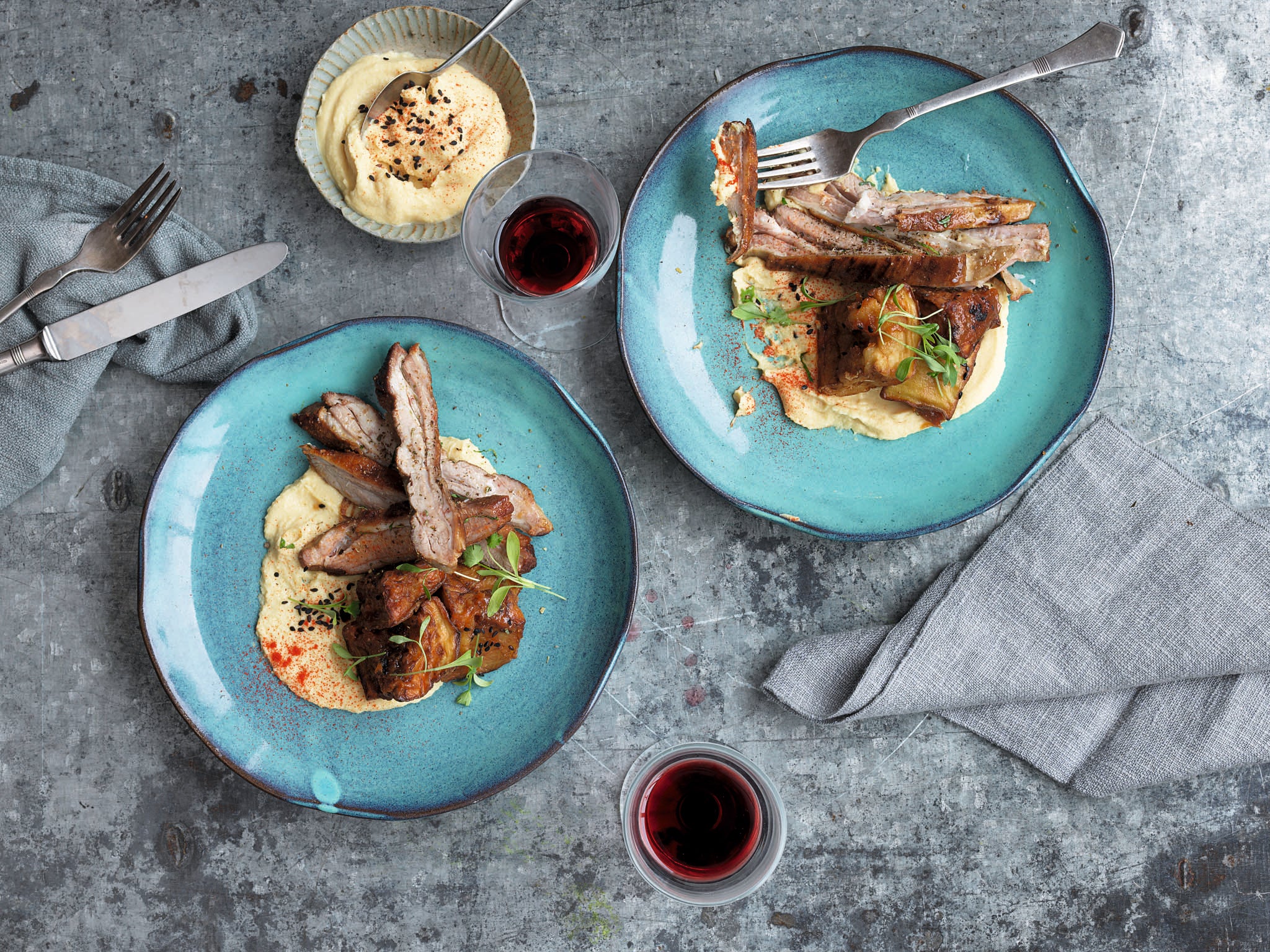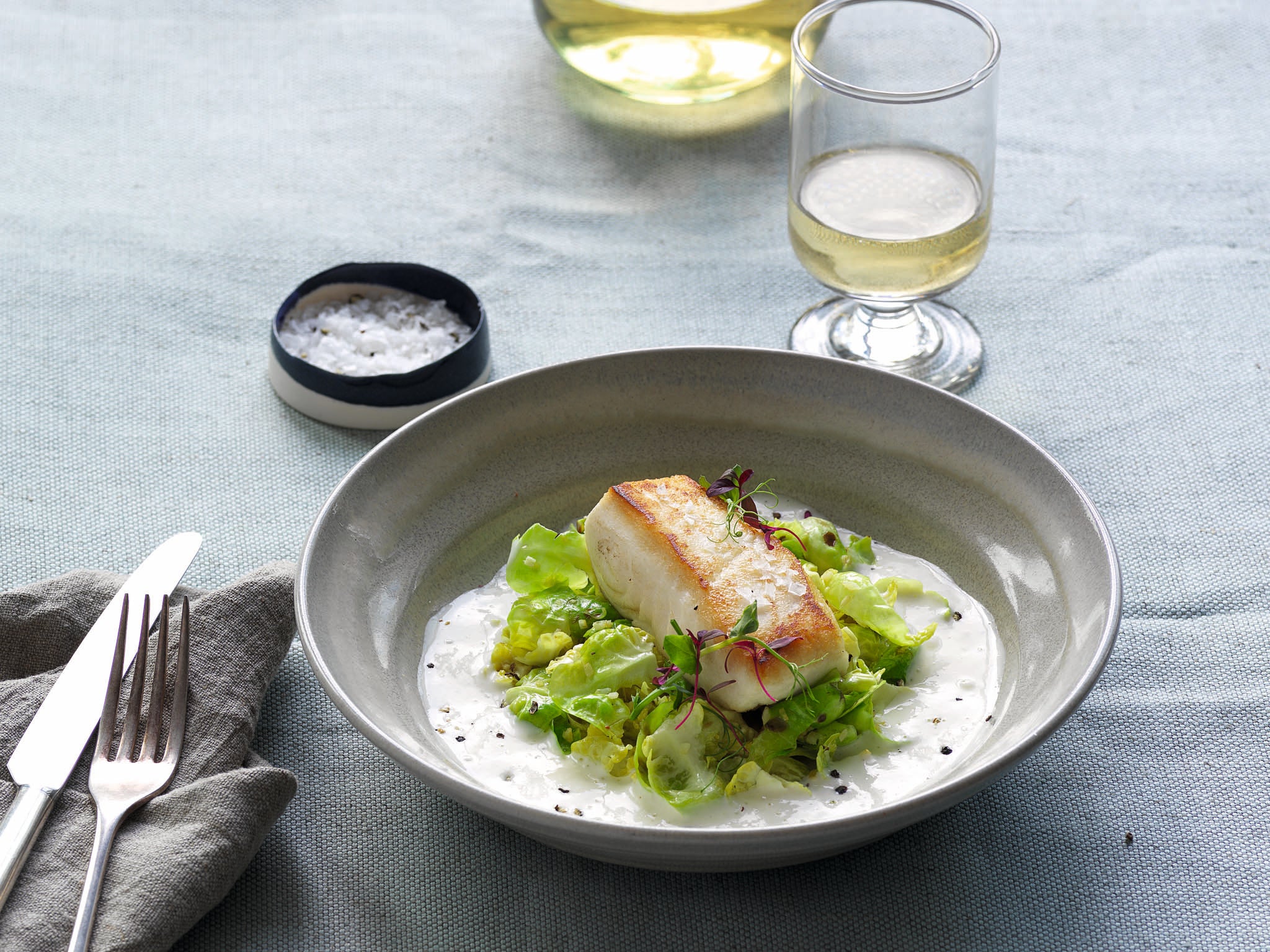Mazi cookbook: From crispy lamb belly to sea bream tartare
After vowing to revolutionise Greek food in the UK, the team behind popular London restaurant Mazi are bringing the real food of Greece to the table at home with their debut cookbook

Crispy lamb belly with miso aubergines and chickpea and tahini puree
We wanted to replicate the taste of the succulent, smokey, grilled lamb cutlets enjoyed at traditional village tavernas in the Greek mountains. Lamb belly is a fatty, juicy piece of meat that serves well in recreating that authentic eating experience, and matching it with aubergines and a chickpea and tahini purée will leave you craving more.
Serves 4
Olive oil
2 lamb breasts, cut into 4 equal pieces
1 small onion, roughly chopped
1 carrot, peeled and roughly chopped
1 celery stick, roughly chopped
3 garlic cloves, halved
1 sprig of rosemary
5 aubergines
200ml sunflower oil, for frying the aubergines
Potato starch, for sprinkling over the aubergines
Salt and pepper
For the miso paste
250ml dry white wine
250g caster sugar
120ml mirin
500g white miso paste (we use Hikari)
For the chickpea and tahini purée
500g soaked and cooked dried chickpeas (boiled for at least 50 minutes until soft) or use drained canned chickpeas
100ml water
Juice of 1 lemon
1 tbsp tahini
1 garlic clove, peeled
4 tsp extra virgin olive oil
Salt
To garnish
Pinch of sweet paprika
Pinch of finely chopped coriander leaves
Pinch of micro herbs
Sprinkling of nigella seeds
Preheat the oven to 180C/gas mark 4. Heat a heavy-based frying pan over a high heat until very hot and add a drizzle of olive oil. Season the lamb breasts with salt and pepper and sear them for 1-2 minutes on each side to get them a bit crispy and golden brown. Remove from the pan to a large oval casserole dish (ideally a cast iron one, such as Le Creuset). Replace the oil in the frying pan with a fresh drizzle. Add the onion, carrot, celery and garlic and sweat over a medium heat until softened. Transfer the vegetables to the casserole and add the rosemary.
Pour over enough water to cover the lamb, cover with the lid and braise in the oven for 3 hours. Meanwhile, prepare the miso paste. Set a smaller saucepan over a larger one containing some barely simmering water to create a bain-marie. Add the wine, sugar and mirin, and stir until the sugar has dissolved. Add the miso paste and whisk until completely incorporated, then leave for about 2 hours until the mixture has reduced by half, stirring occasionally. Remove from the heat and set aside.
Peel the aubergines and cut them into big chunks. Put them in a colander, sprinkle with a very generous pinch of salt and set them aside to drain for an hour. Remove the lamb belly from the oven and leave it to rest for an hour. While the lamb is resting, heat the sunflower oil in a deep saucepan over a high heat. Pat the aubergine chunks dry with kitchen paper, then sprinkle with potato starch to coat. Fry in the hot oil, in batches, for 1 minute until crispy.
Drain and place on a plate lined with kitchen paper to soak up the excess oil.
For the chickpea and tahini purée, blend all the ingredients together in a food processor or blender and set aside until ready to serve.
Towards the end of the lamb resting time, preheat the oven to 200C/gas mark 6. Heat a griddle pan over a high heat, or an indoor grill if you have one – or use a barbecue in the summer months. Cut the lamb belly into thick strips and griddle or grill them on both sides until they are crispy on the outside. Meanwhile, brush the aubergines with the miso paste, place on a baking tray and warm them up in the oven for a few minutes.
Serve the chickpea and tahini purée topped with the lamb belly strips and miso aubergines, sprinkled with the paprika, coriander, microherbs and nigella seeds.

Halibut with brussels sprouts and avgolemono sauce
Avgolemono is a traditional Greek sauce made with eggs and lemon, which usually accompanies winter meat dishes and soups. We have instead paired it with fish and brussels sprouts for an unusual take on the original that works really well. This is a quick and easy dish to prepare but one that is big on flavour and health benefits.
Serves 6
500g brussels sprouts
6 skinless halibut fillets, 100g each
2 pinches of salt
Extra virgin olive oil
1 tsp peeled and finely chopped fresh root ginger
Grated zest of 1 lemon
Pepper
Sprinkling of microherbs, to garnish
For the avgolemono sauce
500ml vegetable stock
6 eggs
200ml double cream
200g unsalted butter, diced
Juice of 6 lemons
Pinch of salt and pepper
Separate each brussels sprout into leaves, peeling them off one by one. Set aside.
For the avgolemono sauce, heat the vegetable stock in a saucepan, add the eggs and cream to the hot stock and blend with a stick blender. Bring to the boil over a medium heat and cook, whisking constantly, until the mixture thickens. Add the butter, lemon juice and the salt and pepper and continue cooking, whisking constantly, until it thickens again. Remove the pan from the heat and pass the mixture through a fine-mesh sieve into a bowl.
Heat a heavy-based frying pan over a high heat. Season the halibut fillets with the salt and some pepper. Drizzle 1 tablespoon of olive oil into the hot pan, then add the halibut fillets and sear for 2 minutes on each side, until both sides are golden brown.
Meanwhile, in a separate frying pan, heat a drizzle of olive oil over a medium heat, add the brussels sprout leaves and sauté for 30 seconds. Add the ginger and lemon zest and sauté for a further 30 seconds. Divide the brussels sprout leaves between 6 dishes and top with the halibut fillets. Pour the warm avgolemono sauce around and sprinkle over the microherbs.

Sea bream tartare
Sea bream is one of the many Mediterranean fish to be found in abundance in Greek waters, although it’s also common in the Atlantic. Grilling is the traditional treatment for this fish, originating from the Cyclades, but preparing it as a tartare is the new trend that has taken over the country. One of our chefs from Mykonos has devised this distinctive version for Mazi.
Serves 6
2 medium-sized sea bream, cleaned, gutted, filleted and skinned (each fillet about 140g)
½ bunch of coriander, chopped
1 red chilli, finely chopped
80-100ml extra virgin olive oil
Grated zest of 1 lime and juice of ½
½ shallot, finely chopped
2 pinches of salt
Pinch of pepper
For the avocado mousse
600g avocados (about 2-3, depending on size)
1 tsp chopped red chilli
1 bunch of coriander
Juice of 1½ limes
Pinch of salt
Pinch of pepper
Finely dice the fish fillets. Add to a glass or ceramic bowl with the rest of the main ingredients, mix together and set aside at room temperature while you prepare the avocado mousse.

Cut each avocado in half and remove the stone, then peel the flesh. Add to a food processor or blender with the rest of the ingredients and blend until creamy.
To serve, divide the avocado mousse between plates and arrange the sea bream tartare on top.
Tip: the more lime juice you add to this, the better
Mazi: Modern Greek Food by Christina Mouratoglou and Adrien Carré is out now. Photography by Nicolas Buisson. Published by Octopus (£25)
Join our commenting forum
Join thought-provoking conversations, follow other Independent readers and see their replies
Comments
Bookmark popover
Removed from bookmarks